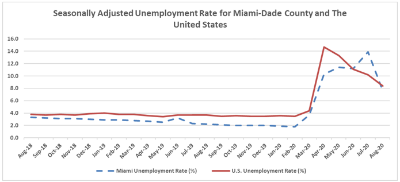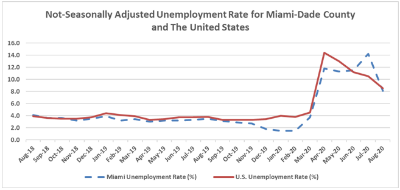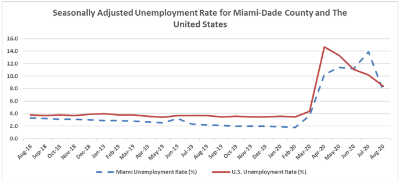Miami, FL - During August 2020, the not seasonally adjusted unemployment rate in Miami-Dade County was 8 percent. From August 2019 to August 2020, the County had a reduction of 75,800 nonagricultural payroll jobs (not seasonally adjusted), which indicate a 6.2 percentage point decrease. From July 2020 to August 2020, there was an increase of 16,000, which reflects a 1.4 percent increase of nonagricultural payroll jobs.
Non-agricultural Payroll Jobs
Due to the impact of COVID-19, there continues to be a sharp decline in non-agricultural payroll jobs throughout most industries when comparing year over year (August 2019 with August 2020). The sectors most affected are Leisure & Hospitality (-35,300), Education & Health Services (-10,300), Professional & Business Services (-8,700), Retail Trade (-8,200), Transportation, Warehousing, & Utilities (-3,900), Wholesale Trade (-3,300), and Manufacturing (-3,200). The sectors seeing some improvements in the past 12 months are Total Government (+1,200), Construction (+700), and Financial Activities (+100). The graph below shows the payroll data since August 2018.
From August 2019 to August 2020 there was a reduction of 75,800 non-agricultural payroll jobs. From July 2020 to August 2020 there was an increase of 16,000 non-agricultural payroll jobs.
 The change in non-agricultural payroll job between July 2020 and August 2020 shows that several sectors have added jobs, including in sectors that were the hardest hit during the onset of the COVID-19 crisis. These sectors include Total Government (+13,000), Transportation, Warehousing, and Utilities (+2,100), Professional and Business Services (+4,300), Education and Health Services (+1,500), Retail Trade (+1,500). The increase in Total Government can primarily be attributed to faculty and staff reentering the workforce for the new school year.
The change in non-agricultural payroll job between July 2020 and August 2020 shows that several sectors have added jobs, including in sectors that were the hardest hit during the onset of the COVID-19 crisis. These sectors include Total Government (+13,000), Transportation, Warehousing, and Utilities (+2,100), Professional and Business Services (+4,300), Education and Health Services (+1,500), Retail Trade (+1,500). The increase in Total Government can primarily be attributed to faculty and staff reentering the workforce for the new school year.
 Not seasonally adjusted unemployment rate
Not seasonally adjusted unemployment rate
The not seasonally adjusted unemployment rate of 8.1 percent compared to last year was 5.5 percentage points higher than the unemployment rate at 2.6 percent in August 2019. Compared to July 2020 there was a 6.4 percentage point decrease from the unemployment rate at 14.5 percent. Below the graph compares the unemployment rate for Miami-Dade County with that of the United States since August 2018. It shows that Miami-Dade County was tracking the unemployment rate of the United States at a slightly lower rate from November 2018 through May 2020, at which point the Miami-Dade County unemployment rate tracked higher due to our strong hospitality and tourism industry being impacted by COVID-19. In August 2020, Miami-Dade County’s unemployment rate once again fell below the United States unemployment rate by 0.4 percent.

 Seasonally adjusted unemployment rate
Seasonally adjusted unemployment rate
In August 2020, the seasonally adjusted unemployment rate for Miami-Dade County (taking seasonal fluctuations in the labor force into consideration) was 7.6 percent, which is 5.4 percentage points higher than in August 2019.
 From the data and analysis above, we continued to observe the impact of COVID-19 in our local economy. Nevertheless, the community needs to remain focused on job-retention projects in targeted industries, as well as all sectors. These industries have been identified as the Miami-Dade County industries most able to create additional well-paying job opportunities, leading to an improved quality of life for Miami-Dade County residents. The Miami-Dade Beacon Council continues to aggressively work on attracting new companies to our community and work on the expansion and retention of existing business. For more information, visit www.beaconcouncil.com.
From the data and analysis above, we continued to observe the impact of COVID-19 in our local economy. Nevertheless, the community needs to remain focused on job-retention projects in targeted industries, as well as all sectors. These industries have been identified as the Miami-Dade County industries most able to create additional well-paying job opportunities, leading to an improved quality of life for Miami-Dade County residents. The Miami-Dade Beacon Council continues to aggressively work on attracting new companies to our community and work on the expansion and retention of existing business. For more information, visit www.beaconcouncil.com.
The job creation numbers are derived from the U.S. Bureau of Labor Statistics Current Employment Statistics Program (CES), and only account for non-farm payroll jobs. However, the unemployment rates are derived from the U.S. Bureau of Labor Statistics Local Area Unemployment Statistics Program (LAUS), which includes farm payroll jobs as well as self-employed workers.
In addition, the federal government typically conducts interviews in sample households to determine the unemployment rate. Miami-Dade County is one of six metropolitan areas in the United States that uses a different method solely based on a statistical model derived from several data sets.


